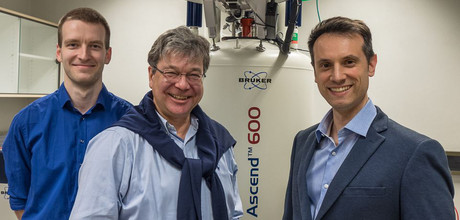How Noroviruses control their desire for sweets

Robert Creutznacher, Prof. Dr. Thomas Peters und Dr. Alvaro Mallagaray (v.l.n.r.; Foto: Dr. Thorsten Biet)
The scientific journal Nature Communications reports on these findings in its latest issue.
The researchers Alvaro Mallagaray and Robert Creutznacher of the group around Thomas Peters (Director of the Institute of Chemistry and Metabolomics) noticed peculiar spectral alterations during their NMR experiments with viral coat proteins.
First, these observations were difficult to explain as, so far, no transformations of norovirus coat proteins had been detected in Lübeck or other laboratories worldwide.
The unexpected observation was only possible since in recent years the Lübeck researchers had succeeded in labeling norovirus coat proteins with non-radioactive isotopes in such a way that the NMR spectroscopic fingerprints of these proteins could be decoded almost completely.
With these fingerprints in hand, it is now possible to gain deep insights into the attachment of norovirus coat proteins to sugar structures on the surface of host cells or bacteria, present in the gut microbiota.
The attachment of Noroviruses to distinctive sugar chains, the so called histo blood group antiens (HBGAs), is considered as essential for successful infection and, therefore, is target of a number of studies, aiming at the development of antiviral agents specifically blocking the interaction between virus and host.
The cause of the observed spectral alterations emerged as a surprise from elaborate three-dimensional NMR experiments, so called HN(CO)CACB NMR experiments, when deciphering the protein fingerprints. The data indicated that an amino acid residue adjoining the sugar binding site undergoes a relatively rapid spontaneous transformation, effectively suppressing sugar binding.
Such so called post translational modifications are known but so far had not been associated with interactions of viral coat proteins with host cell factors or receptors.
The results from the Lübeck laboratory were confirmed by other groups as part of a collaboration within the DFG (Deutsche Forschungsgemeinsachft) funded research unit ViroCarb. The group of Charlotte Uetrecht from the Pette Institute in Hamburg delivered supporting evidence from mass spectrometry, and the group of Bärbel Blaum at the University of Tübingen contributed structural details of the altered sugar binding from crystallography experiments.
Analysis of gene sequences of Norovirus strains involved in currently prevalent epidemies shows that ca. 60% of all viruses have the potential to undergo this spontaneous post translational modification, modulating their interactions with host cells or bacteria. To date, it is not known if and how noroviruses benefit from this transformation, but unquestionably this discovery will impact the search for novel antivirals and the development of vaccines.
Prof. Dr. rer. nat. Thomas Peters
Universität zu Lübeck
Telefon: +49 451 3101 3300
Fax: +49 451 3101 3304
E-Mail: thomas.peters@chemie.uni-luebeck.de
https://www.nature.com/articles/s41467-019-09251-5
https://www.uni-luebeck.de/aktuelles/pressemitteilung/artikel/wie-noroviren-ihre…
Media Contact
All latest news from the category: Life Sciences and Chemistry
Articles and reports from the Life Sciences and chemistry area deal with applied and basic research into modern biology, chemistry and human medicine.
Valuable information can be found on a range of life sciences fields including bacteriology, biochemistry, bionics, bioinformatics, biophysics, biotechnology, genetics, geobotany, human biology, marine biology, microbiology, molecular biology, cellular biology, zoology, bioinorganic chemistry, microchemistry and environmental chemistry.
Newest articles

Silicon Carbide Innovation Alliance to drive industrial-scale semiconductor work
Known for its ability to withstand extreme environments and high voltages, silicon carbide (SiC) is a semiconducting material made up of silicon and carbon atoms arranged into crystals that is…

New SPECT/CT technique shows impressive biomarker identification
…offers increased access for prostate cancer patients. A novel SPECT/CT acquisition method can accurately detect radiopharmaceutical biodistribution in a convenient manner for prostate cancer patients, opening the door for more…

How 3D printers can give robots a soft touch
Soft skin coverings and touch sensors have emerged as a promising feature for robots that are both safer and more intuitive for human interaction, but they are expensive and difficult…





















